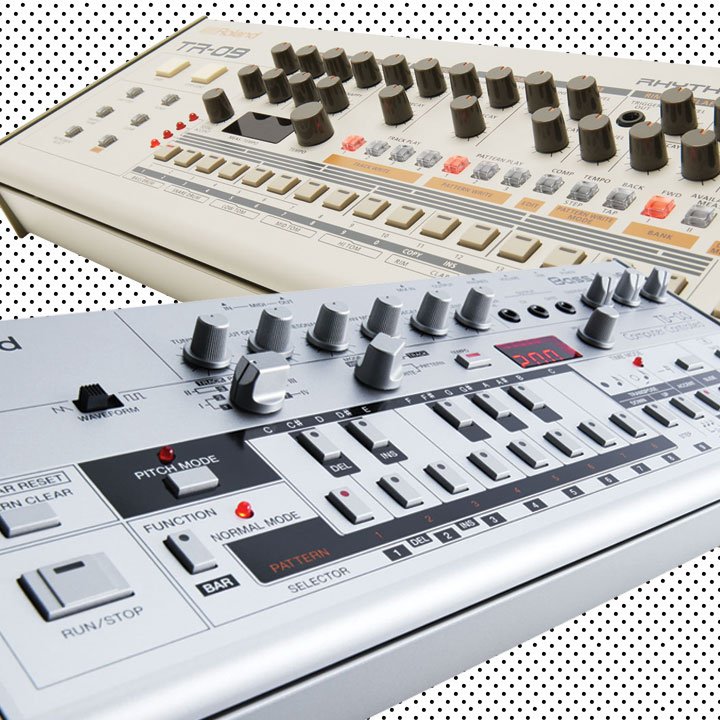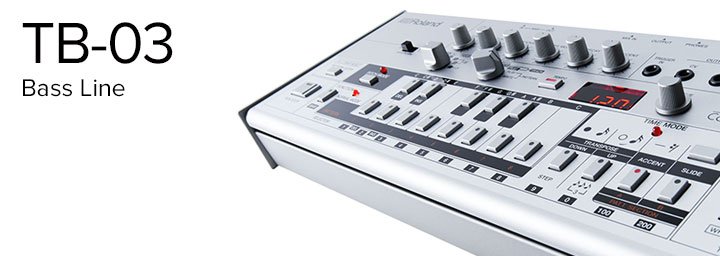In the past few years, we have seen a huge resurgence in both analog and digital hardware. Eurorack modular synthesizer systems have exploded in popularity and vintage synth prices have skyrocketed. The tactile experience of using hardware instruments is drawing artists back to tabletops filled with drum machines and synthesizers.
The original Roland TB-303 Bass Line and Roland TR-909 Rhythm Composer were a combo that contributed largely to defining the Acid House sounds of the late ’80s and early ’90s. They would often be used together live, giving the artist a hands-on workflow that some feel has been lacking in today’s live electronic scene. Last year, these two machines were reissued as the Roland TB-03 Bass Line and the Roland TR-09 Rhythm Composer. Both are part of the Roland Boutique line of synthesizers.
Using Roland’s Analog Circuit Behaviour (ACB) technology, they are compact and faithful recreations of the originals. They can be operated in the exact same way. However, there are some additional functions for those who want a more modern approach. Using hardware machines together live is a skill that some artists have honed over many years. The TB-03 and TR-09 combo is a great starting point to throw oneself into live performance and programming.
Contributed by Roland Canada
Making the Connection.
Along with a USB Audio/MIDI connection and traditional MIDI jacks, we have analog interfacing options on the Boutique TB-03 and TR-09. There are different advantages with all types of connections. This versatility allows us to approach these instruments in a few different ways.
The trigger input on the TB-03 is ready to take an analog trigger signal and goes directly to the heart of the sequencer. This type of signal is simply a spike in voltage – a quick rising edge – that will advance the internal step sequencer 1 step forward per trigger received. This is perfect to pair with the trigger output of the TR-09. Connecting the two instruments in this fashion is a great way to tempo sync them together with no MIDI, no computers, and with the TR-09 as the “Master Clock”.
Connect an unbalanced 3.5mm cable from the trigger output on the TR-09 into the trigger input on the TB-03.
Sequencing.
The TR-09 sequencer will be controlling its trigger output. Press [START] on the TR-09, hold down [Instrument Select] + [Menu]. Now we are ready to sequence. Program the trigger part like this:
XXXXXXXXXXXXXXXX
Press [RUN] on the TB-03. This type of trigger sequence is essentially clocking the two instruments together. For every step the TR-09 moves, the TB-03 moves along with it.
In contrast to syncing these pieces together via MIDI, the only function that the analog trigger connection provides is moving the sequencer forward. It will NOT reset the sequencers together when starting and stopping the TR-09, as would be the case with MIDI sync. This means that we can start and stop the sequencer on the TB-03 whenever we want, without having to reset our master clock. This can prove very useful for live situations. We can find many variations on our pattern by starting it at different points.
Another advantage of the analog sync is that it can advance the TB-03 sequencer at any point in the TR-09 sequence. A good example of this would be to program the trigger out of the TR-09 as follows:
X_X_X_X_X_X_X_X_
With triggers programmed on every OTHER step, the TB-03 sequencer advances at half the speed of the TR-09, moving 1 step on the TB-03 for every 2 steps taken on the TR-09. We can keep “dividing” the speed down all the way to 1 step for every 16.
We can get creative by sending triggers with different rhythms to make interesting long, repeating patterns.
Sharing the Groove.
The shuffle on the TR-909 was a huge part of its revered sound. When we use the trigger output on the TR-09 it will reflect the swing setting, allowing us to impart that groove on the TB-03 sequence.
Extra Performance Features.
There have been updates made to these pieces that allow for some powerful on-the-fly tweaking. Firmware 1.04 update for both the TR-09 and TB-03 has added the following features:
Mute/Solo menu on the TR-09: By pressing and holding [Instrument Select] + [Shift] we are now able to press [Enter] to select either muting or soloing parts with the 16 programming buttons. This allows us to do some interesting things that were never possible on an original TR-909, such as muting just the open or just the closed hi hats while maintaining our sequence.
Copy and Randomize on the TB-03: When in Pattern Write mode, we can now hold [Function] + [F#] to copy our current pattern, then simply select and hold the pattern location we want to paste it to and press [Write]. There are also two new randomize functions. Holding [Function] + [G#] will create a totally new random sequence at our current pattern location (Random 1). Holding [Function] + [A#] will randomize the octave shifts, slides, and accents of our current pattern (Random 2).
The combination of Copy and Random 2 is a great way to get quick variations on a pattern we are working with. In a live situation, we can simply copy over the pattern we are on, then randomize those three aspects of it to get new grooves while maintaining our notes.
Even More to Check Out.
We can edit patterns while they are playing on both the TB-03 and TR-09. Step sequencing on-the-fly can lead to some ideas that wouldn’t come out in any other way.
The CV/Gate outputs on the TB-03 provide a copy of the programmed sequence to be sent to any other analog gear that is equipped with 1V/Oct CV/Gate control inputs. This will work with vintage gear such as the Roland SH-101 Analog Synthesizer and Roland System 100m Semi-Modular Synthesizer as well as with modern pieces such as the Roland SYSTEM-500 Modular Synthesizer or Roland SYSTEM-1m PLUG-OUT Synthesizer. This is also the standard that has been adopted by all Eurorack modular synthesizers. This means that the TB-03 can be used as both a synthesizer and a sequencer.
Digging in to hardware can lead to some of the most rewarding experiences an electronic musician can have. Go out and play, tweak knobs, experiment, and most importantly, have fun!
Related Articles
HOW TO GET THE MOST OUT OF YOUR ROLAND BOUTIQUE WITH MIDI MAPPING
SEVEN MORE HIDDEN FEATURES OF THE ROLAND BOUTIQUES
USING YOUR ROLAND BOUTIQUE WITH ABLETON LIVE
TB-03 VS. TB-3
TR-09 VS. TR-8






